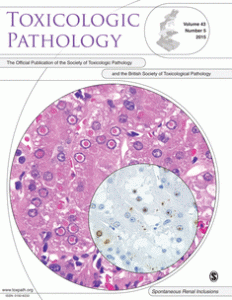 The authors of a paper on parasitic nematodes have retracted the article because they misidentified the organism in question, so “the possibility of misleading readers was high.”
The authors of a paper on parasitic nematodes have retracted the article because they misidentified the organism in question, so “the possibility of misleading readers was high.”
The paper, “Histopathological features of Capillaria hepatica infection in laboratory rabbits,” appeared in Toxicologic Pathology in 2009 and came from a lab at Huntingdon Life Sciences, in Cambridgeshire, England.
According to the abstract:
Capillaria hepatica is a nematode parasite of wild rodents and other mammals. Adult worms inhabit the liver. Recently, during the necropsy examination of a group of 160 rabbits from a commercial supplier, firm pale or cystic areas (1-5 mm) were noted on the liver in thirteen animals. On further investigation, these animals were found to be infected with C. hepatica…The unique characteristics of the C. hepatica life cycle are described, and the differential diagnosis of hepatic capillariasis is discussed.
Evidently not so unique after all. Per the retraction notice:
The paper described the pathology associated with what was thought to be a nematode parasite, Capillaria hepatica. The figures that appear in the manuscript show another parasite, Eimeria spp and do not show the nematode. While some of the hepatic pathology described might have been attributed to infection with the Capillaria, the absence of definitive proof meant that the possibility of misleading readers was high and it was, with the agreement of the authors, decided to withdraw the manuscript to avoid this possibility.
We were curious why it took six years to figure out they had the wrong parasite, and emailed the authors for more information. We’ll update this post if we hear anything.
The paper has been cited six times, according to Thomson Scientific’s Web of Knowledge.
Like Retraction Watch? Consider supporting our growth. You can also follow us on Twitter, like us on Facebook, add us to your RSS reader, and sign up on our homepage for an email every time there’s a new post. Click here to review our Comments Policy.
I think that the retraction is being misinterpreted because it is confusing (“thought to be a nematode parasite” makes it sound like they couldn’t differentiate a multi cellular metazoan from a protozoan).
There wasn’t necessarily a parasite misidentification, but rather that the claim that the liver injury is due to the nematode was not substantiated by the figures in the paper.
The images show clear evidence of nematode eggs, but no adults are pictured. Since Eimeria is also present, it could be that most of the tissue injury is due to Eimeria. Therefore, the conclusion that the nematode was the main cause of the injury is not strong, and the paper was retracted.